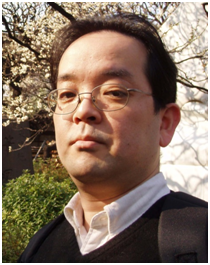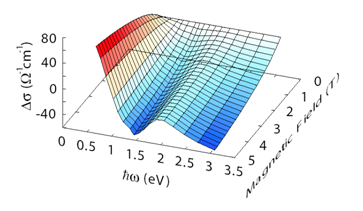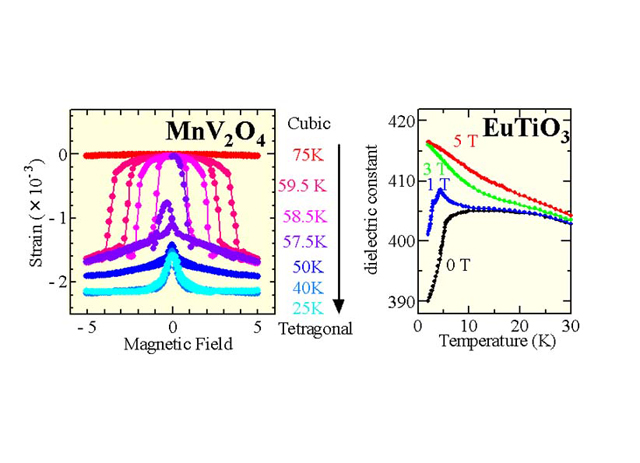
ページ読込中...

ページ読込中...

[English]
| 勝藤 拓郎 [教授] |  |
|
| homepage | https://katsuf.w.waseda.jp/lab/ | |
| 専門分野 | 物性物理学 | |
| 研究テーマ・研究活動 | ||
| ○遷移金属酸化物の物質開発 ○光学測定による強相関電子系の研究 ○巨大外場応答を示す物質の開発、研究 |
||
| ●日本物理学会 ●応用物理学会 ●アメリカ物理学会 |
||
みなさんの身の回りにある物質のほとんどは「固体」と呼ばれるもので、ミクロに見ると、原子が順序よく整列しており、その間を電子が飛び回っています。一見簡単に見える舞台ですが、実はこれだけで驚くほど多様な性質が生み出されるのです。よく知られている例として、電気が流れたり(金属)、流れなかったり(絶縁体)、磁石についたり(強磁性)、もう少し高級な例としては、近年のノーベル賞の対象となった超伝導、量子ホール効果などは、すべて固体中の電子が生み出す性質です。固体中においては、一つの現象に対して数多くの電子が一度に寄与するために、このような多彩な性質が現れるのです。1つ1つの電子は波動方程式(シュレディンガー方程式)に従いますが、電子が多数集まったとき、そこは単純な方程式を超えた新しい物理の宝庫です。
こうした多様で複雑な性質を研究するにはどうしたらいいでしょうか?まず、舞台となる物質をつくってやらなければなりません。新しい物理は新しい物質から生み出されるというのは、これまでの歴史の教えるところです。我々のグループは、新しい物理を生み出すべく、新物質の開発を行っています。特に、動きまわる電子同士の間に強い相互作用が働く「強相関電子系」の物質開発に力を入れています。さらに、新しい現象を見つけるためには、それを「見る」ための手段を手に入れなければなりません。我々のグループは、光を用いた測定手法を中心に、新しい物理を見るための手段を開発しています。このように、物質開発と測定の両輪をフル回転させて、新しい物理の探索にいそしんでいます。
。

右の図は、マンガン酸化物という物質で我々が発見した、「有限周波数の電気伝導度」が磁場によって変化する様子です。これは電子が持つ「電荷自由度」と「スピン自由度」が結合することによって生じる新奇な現象であり、そのダイナミクスを明らかにする研究が進んでいます。
| Takuro Katsufuji [Professor] |  |
|
| homepage | https://katsuf.w.waseda.jp/lab/ | |
| research field | New physics through new materials | |
| research keywords | ||
| Strongly-correlated electron systems Synthesis of new materials Optical spectroscopy of materials |
||
| link | ||
| Research Profiles (at Faculty of Science and Engineering)Research Profiles (Elsevier SciVal Experts) | ||
While the behavior of a single electron obeys the Schrodinger equation and is physically counterintuitive, the principle in question is quite simple. However, real-world objects consist of countless electrons, and the collective motion of such large numbers of electrons differs radically from the motion of a single electron. Each material acts as a “stage” for electrons which, in this analogy, may be regarded as “actors.” The actors (the electrons) behave in different ways in different materials (on different stages). The potentially novel behavior of electrons on novel stages presents an avenue for exploring the physics of new materials.
Our group is currently seeking to synthesize new materials, grow new crystals, and explore new physics in these materials. In particular, we focus on transition-metal oxides, in which electrons are strongly correlated and tend to act collectively (called “strongly-correlated electron systems”). Due to the collective behavior of correlated electrons, transition-metal oxides often exhibit a large response to external fields, sometimes generating surprising behavior. For example, applying a magnetic field to some common materials will result in magnetization. Applying a magnetic field to transition-metal oxides may lead to changes in electrical resistance, dielectric constants, crystal structures, and even color. In addition to their interest in terms of basic physics, such phenomena present the potential for future applications.
To date, we have observed the following phenomena: (1) Magnetic-field-induced structural phase transitions in spinel MnV2O4, a phenomenon arising from the coupling of the orbital and spin degrees of freedom of the V ion; (2) large changes in dielectric constant in a perovskite (EuTiO3) when a magnetic field is applied, a phenomenon arising from the coupling between Eu spins and the electric dipole on Ti; (3) significant changes in color in a perovskite (Pr0.6Sr0.4MnO3) and pyrochlore (Yb2V2O7) when a magnetic field is applied; (4) significant changes in electrical resistance when a magnetic field is applied to La- and Cr-doped perovskite (SrTiO3). We wish to emphasize that such physical phenomena represent only a small portion of those related to new materials; we expect many more to appear in the near future.
 In conventional electromagnetics, magnetic fields induce magnetization only. In some transition-metal oxides, however, the effects of magnetic fields can be quite varied. (Left) Crystal structure of spinel MnV2O4 changes when a magnetic field is applied. (Right) Dielectric constants of perovskite (EuTiO3) change when a magnetic field is applied.
In conventional electromagnetics, magnetic fields induce magnetization only. In some transition-metal oxides, however, the effects of magnetic fields can be quite varied. (Left) Crystal structure of spinel MnV2O4 changes when a magnetic field is applied. (Right) Dielectric constants of perovskite (EuTiO3) change when a magnetic field is applied.